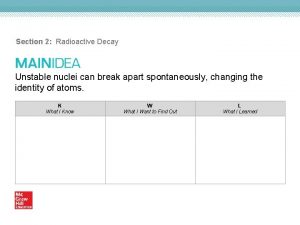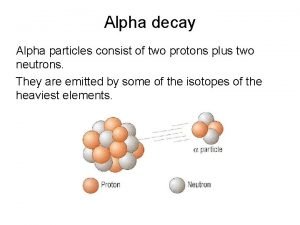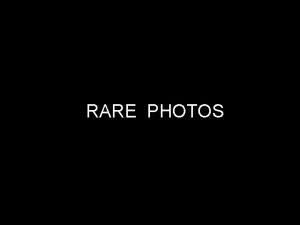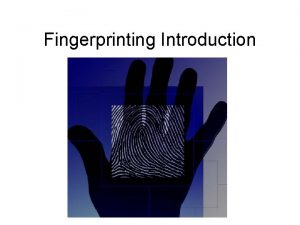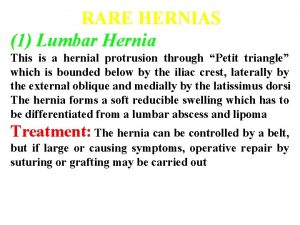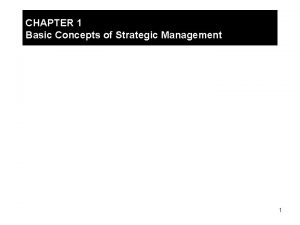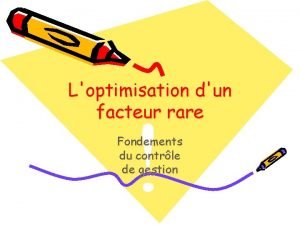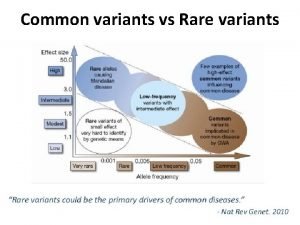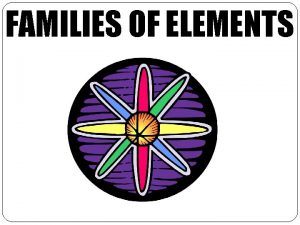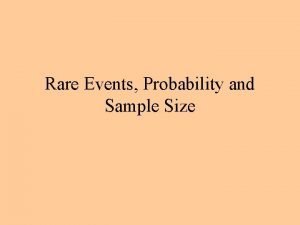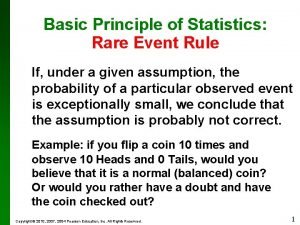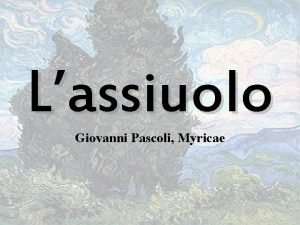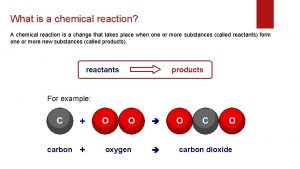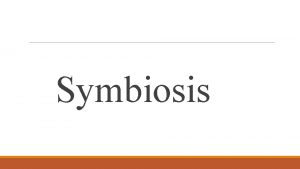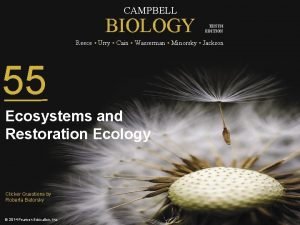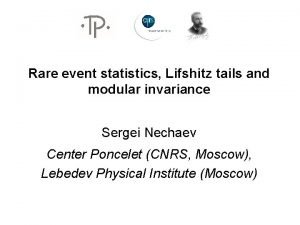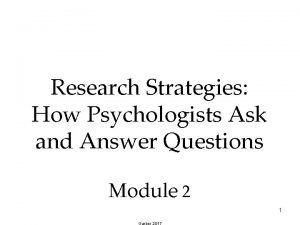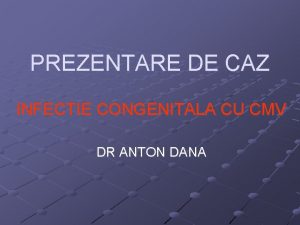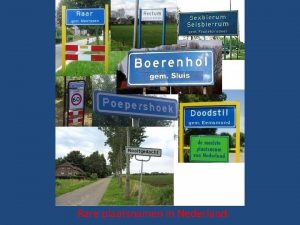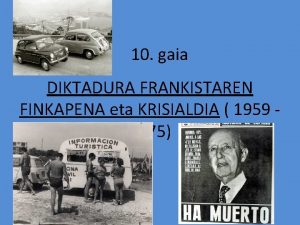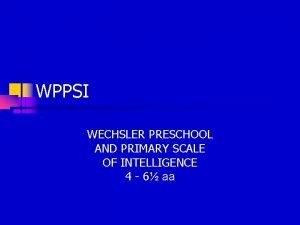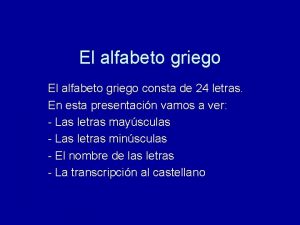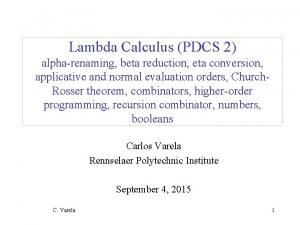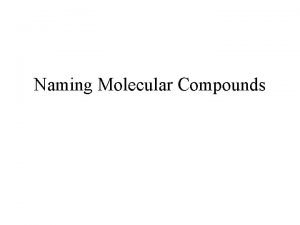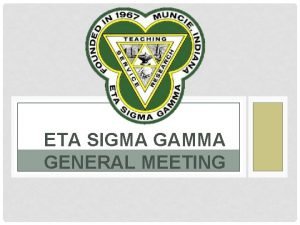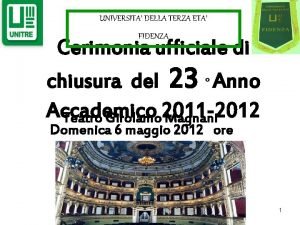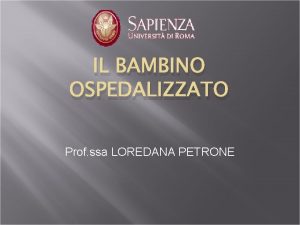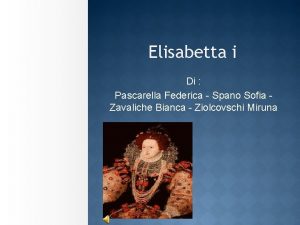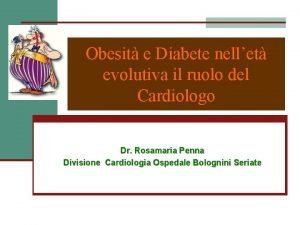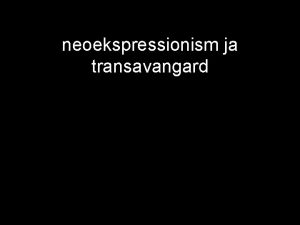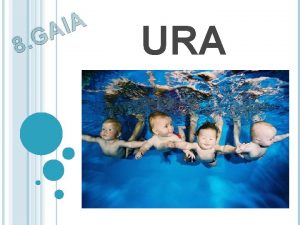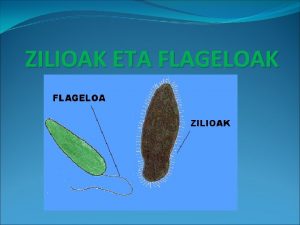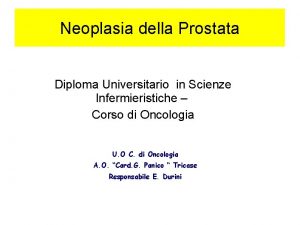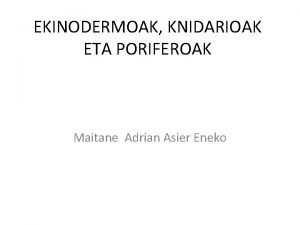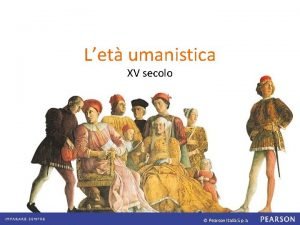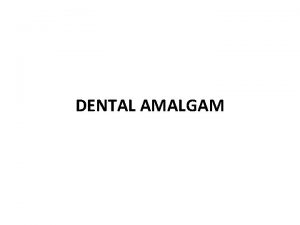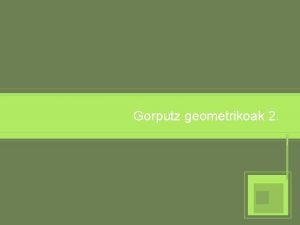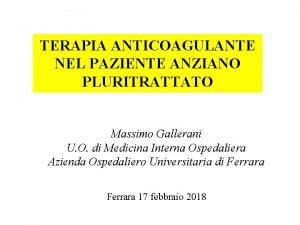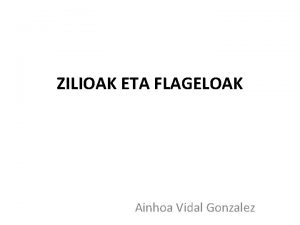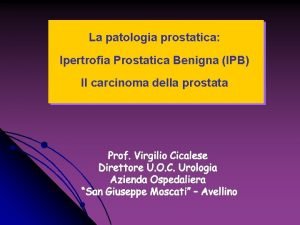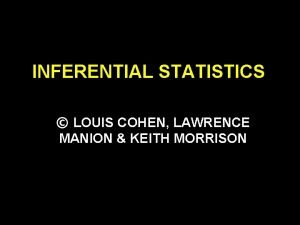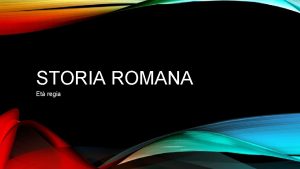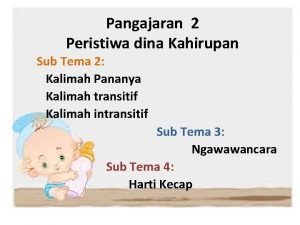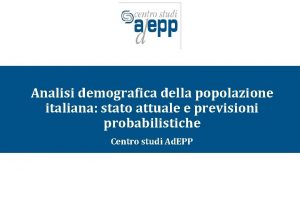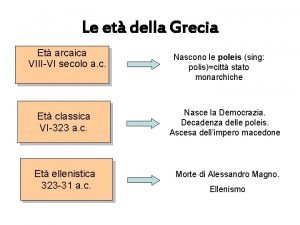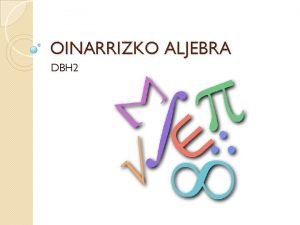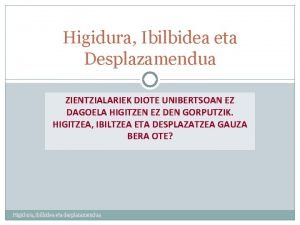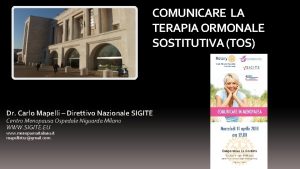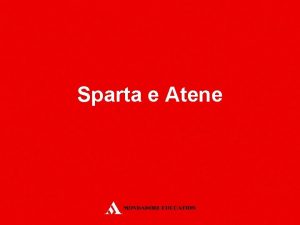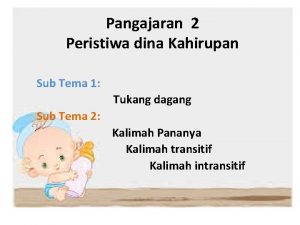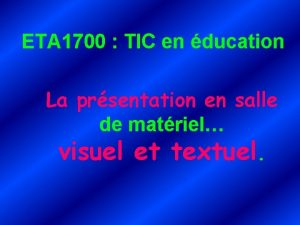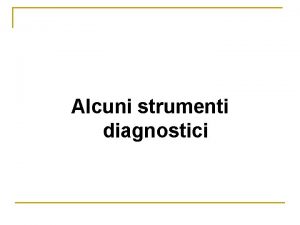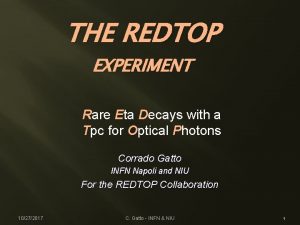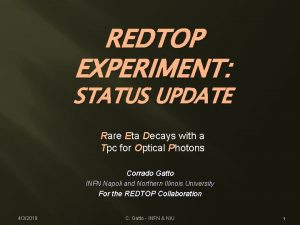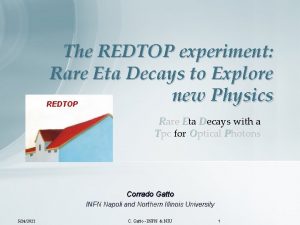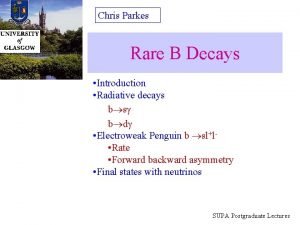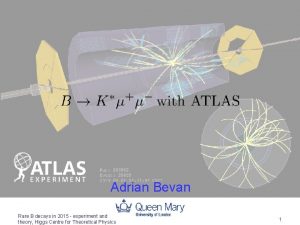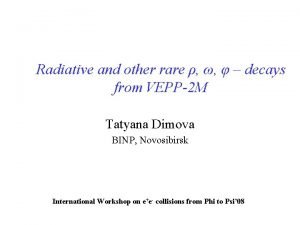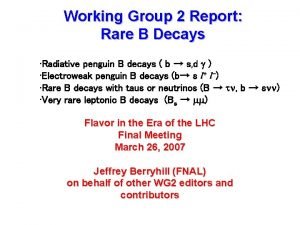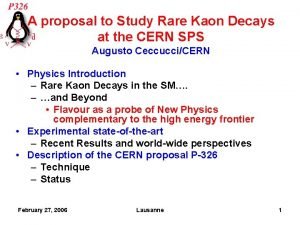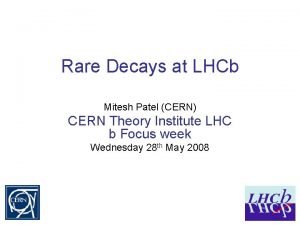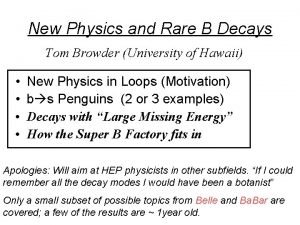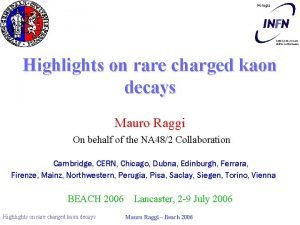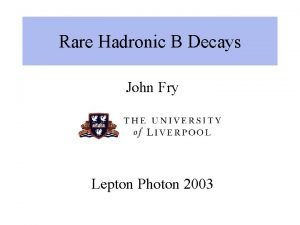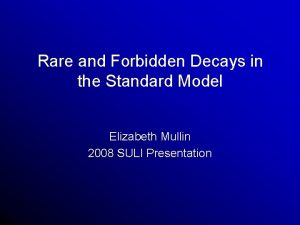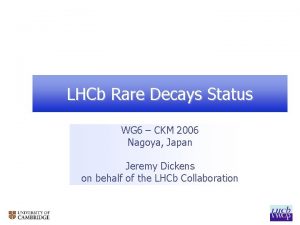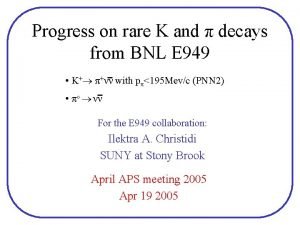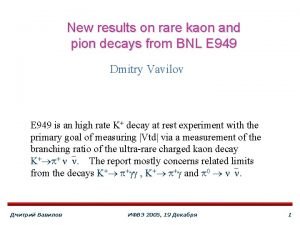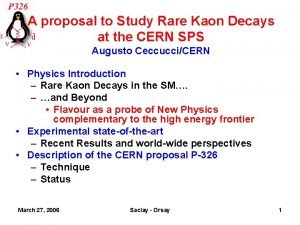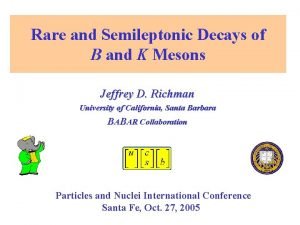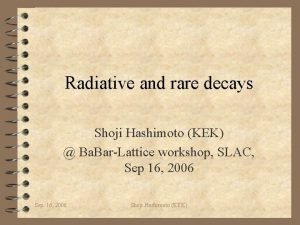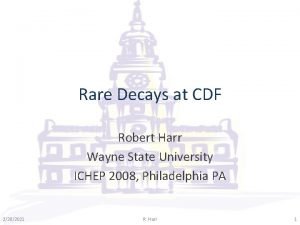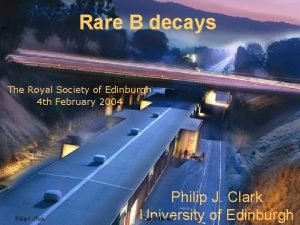THE REDTOP EXPERIMENT Rare Eta Decays with a


























































































- Slides: 90

THE REDTOP EXPERIMENT Rare Eta Decays with a Tpc for Optical Photons Corrado Gatto INFN Napoli and NIU For the REDTOP Collaboration 7/11/2017 C. Gatto - INFN & NIU 1

The Physics Landscape for REDTOP SM is showing its age SM matter: Dark energy=5%: 25%: 70% Baryon Asymmetry of the Universe Expansion of the universe is accelerating (hint to more forces) . . New physics is elusive: probability of processes where new physics is coupled to SM physics is low LHC found no hint of new physics at high energy so far Newest theoretical models prefer gauge bosons in Me. V Ge. V mass range as “…many of the more severe astrophysical and cosmological constraints that apply to lighter states are weakened or eliminated, while those from high energy colliders are often inapplicable” (B. Batell , M. Pospelov, A. Ritz – 2009) High intensity low energy experiments are growing in popularity (Fixed target and beam dump) 7/11/2017 C. Gatto - INFN & NIU 2

Why the h meson is special? It is a Goldstone boson Symmetry constrains its QCD dynamics It is an eigenstate of the C, P, CP and G operators (very rare in nature): IG JPC =0+ 0 -+ It can be used to test C and CP invariance. All its additive quantum numbers are zero Q = I = j = S = B = L = 0 All its possible strong decays are forbidden in lowest order by P and CP invariance, G-parity conservation and isospin and charge symmetry invariance. EM decays are forbidden in lowest order by C invariance and angular momentum conservation The η decays are flavor-conserving reactions Its decays are not influenced by a change of flavor (as in K decays) and violations are “pure” It is a very narrow state (Gh=1. 3 Ke. V vs Gr=149 Me. V) Contributions from higher orders are enhanced by a factor of ~100, 000 Excellent for testing invariances Decays are free of SM backgrounds for new physics search h is an excellent laboratory to search for physics Beyond Standard 7/11/2017 C. Gatto - INFN & NIU Model 3

REDTOP Key Points The experiment will yield 2 x 1013 h mesons/year and 2 x 1011 h’ mesons/year That is a consequence of the relatively large h production cross section (10 -20 mbar in the 2 Ge. V beam energy region) Requires a detector blind to protons and slow charged pions Near-4 p detector can be used with beams of different energy and/or particles 7/11/2017 C. Gatto - INFN & NIU 4

Part I Physics with 2 x 1013 h and 2 x 1011 h’ mesons 7/11/2017 C. Gatto - INFN & NIU 5

REDTOP - Golden Channel I CP Violation from Dalitz plot mirror asymmetry in h-> p+p-po q q q q q 7/11/2017 J. Bijnens and K. Ghorbani, jhep 112007030 (2007) Any mirror asymmetry in the Dalitz plot is an indication of CP and C violation. Such asymmetry does not arise from SM operators at tree level, nor can the operators that generate EDMs contribute to it (at tree level). Consequently, the violation of discrete symmetry resulting from studying this process is not bounded by EDM as is the case for the η→ 4π process. Furthermore, this measurement is complementary to EDM searches even in the case of T and P odd observables, since the flavor structure of the eta is different from the nucleus Current PDG limits consistent with no asymmetry Largest data sample: WASA (1. 2 x 107 – 2014), KLOE 2 (4. 7 x 106 – 2016) Stat. error of violating parameter is comparable with the measured value REDTOP will collect 4 x 1011 such decay (factor 100 in stat. error) C. Gatto - INFN & NIU 6

Old method 7/11/2017 C. Gatto - INFN & NIU 7

7/11/2017 C. Gatto - INFN & NIU 8

REDTOP - Golden Channel II Test of CP invariance via g* polarization studies h → p+p –e+e – and h → p+p –m+m – q CP violation could be investigated by looking at E 1 transitions of the photon in the decay η → π+π– γ. This require the measurement of photon polarization. q If the photon is virtual and it decays decaying into a e+ e– pair: η → π+π– γ* → π+π+ l+l q The following asymmetry is an open window on CP violation: q Φ is the angle between the decay planes of the electron positron pair and the two charged pions 7/11/2017 C. Gatto - INFN & NIU 9

REDTOP - Golden Channel III Dark photon searches: h → g A’ → g + l+l q Motivated from many directions: q q q q 7/11/2017 possible cosmic ray excesses from dark matter annihilation (ex. Pamela, AMS, etc), self interacting DM and explaining small scale structure anomalies in dwarf galaxies: Pospelov and Ritz (2008), Arkani Hamed et al. (2008) the muon g− 2 anomaly. Most accredited model has A’ weakly coupled to the SM via kinetic mixing and has mass in the Me. V – Ge. V range. Kinetic mixing can naturally arise if there are states charged under both U(1)s, even if such states are very heavy. It couples to the Standard Model charged particles with a strength ≤ 10− 3 − 10− 4 of that of the photon This is the natural size of this coupling if we assume it originates from loops of heavy particles The A’ also couples to the SM weak neutral current, with a strength further suppressed by a factor of (m. A’ /m. Z) 2 . C. Gatto - INFN & NIU 10

REDTOP - Golden Channel III Dark photon searches: h → g A’ → g + l+l q The probe of the coupling scales e µ n¼ q Searched in different ways: Low energy colliders ( Babar, Belle, Cleo, Kloe, etc) > not enough statistics Meson decays q q q 7/11/2017 Complements the new experiments at JLAB, Frascati, SLAC, etc. with g and e beams in the Me. V Ge. V energy range h and A’ mass constraints help to reject the background Requires > 1011 eta/eta’ mesons C. Gatto - INFN & NIU 11

REDTOP - Golden Channel III Dark photon searches: h → g A’ → 3 g or g + l+l 7/11/2017 C. Gatto - INFN & NIU 12

REDTOP - Golden Channel III Dark photon searches (near future): h → g A’ → g + l+l 7/11/2017 C. Gatto - INFN & NIU Ilten et al. hep-ph 1603. 08926 13

REDTOP - Golden Channel IIIa Search for super weak gauge boson X with MX=17 Me. V: =17 Me. V h → g X with X→ e+e q q Similar to dark photon searches (but with only 1 mass constraint) Recently postulated to explain a 6. 8 s anomaly in the invariant mass distributions of e+e− pairs produced in 8 Be nuclear transitions – S. Gardner et al (2016) ar. Xiv: 1608. 03591 q Will also explain the 3. 6σ discrepancy between the predicted and measured values of the muon’s anomalous magnetic q Below WASA sensitivity q Boost from h helps to increase sensitivity to 17 Me. V invariant masses 7/11/2017 C. Gatto - INFN & NIU 14

REDTOP - Golden Channel IV Searches for light scalar mesons : h → po H ; H→ m+ m- vs e+ e q Viable DM candidate (in certain circumstances) coupling to Higgs portal M. Pospelov, A. Ritz and M. Voloshin, Phys. Rev. D 78, 115012 (2008) q Occurring in the SM via a two photon exchange diagram with a branching ratio of the order of 10 9. q The existence of a light scalar particle coupling the muons to the quarks will change the dynamics of the process by increasing its probability of occurrence even by several orders of magnitude. q REDTOP’s expected sensitivity is greater that 10 10. q A precision measurement of the BR, along with unitarity constraints and with the measurements from η > πo γγ will reveal if there is any “abnormality” in the two photon channel. It will also provide strong constraints on new physics models where a light new particle mediates interactions. q Postulated scalar meson H could solve the Rp anomaly 7/11/2017 C. Gatto - INFN & NIU 15

REDTOP - Golden Channel V Proton radius anomaly: h → g m+m – vs h → g e+e q Conventional methods (levels of muonic atoms and elastic scattering experiments) find a discrepancy of about 7 s. q Those processes occur mainly trough the exchange of one virtual photon. q h → g l+l can occur either via one photon or two photons q A new light scalar particle S which couples differently to electrons and muons, could mediate the process via a third diagram Consequently, a precise measurement of the branching ratios of the latter might help in explaining the Rp anomaly. 7/11/2017 16

BSM Physics Program (h and h’ factory) C, T, CP-violation q q q q CP Violation via Dalitz plot mirror asymmetry: asymmetry h → po p+p. CP Violation (Type I – P and T odd , C even): h-> 4 po → 8 g CP Violation (Type II - C and T odd , P even): even h → po l+l and h → 3 g Test of CP invariance via m longitudinal polarization: h → m+m – Test of CP invariance via g* polarization studies: h → p+p –e+e – and h → p+p – m+m – Test of CP invariance in angular correlation studies: h → m+m – e+e – Test of T invariance via m transverse polarization: h → pom+m – and h → g m+m – CPT violation: m polariz. in h → p+m-n vs h → p-m+n and g polarization in h → g g Other discrete symmetry violations q q Lepton Flavor Violation: h → m+e – + c. c. Double lepton Flavor Violation: h → m+m+e – + c. c. 7/11/2017 C. Gatto - INFN & NIU 17

BSM Physics Program (h and h’ factory) New particles and forces searches q q q Scalar meson searches (charged channel): h → po H - with H→e+e- and H→m+m Dark photon searches: h → g A’ with A’ → l+l. Protophobic fifth force searches : h → g X 17 with X 17 → e+e. New leptophobic baryonic force searches : h → g B with B→ e+e- or B→ g po Indirect searches for dark photons new gauge bosons and leptoquark: h → m+mand h → e+e. Search for true muonium: h → g (m+m – )|2 Mm → g e+e – Other Precision Physics measurements q Proton radius anomaly: h → g m+m – vs h → g e+e- q All unseen leptonic decay mode of h / h ‘ (SM predicts 10 -6 -10 -9) 7/11/2017 C. Gatto - INFN & NIU 18

BSM Physics Program (h and h’ factory) Non-h/h’ based BSM Physics q q Dark photon and ALP searches in Drell-Yan processes: qqbar → A’/a → l+l– ALP’s searches in Primakoff processes: p Z → p Z a → l+l– (F. Kahlhoefer) Charged pion and kaon decays: p+ → m+n A’ → m+n e+e– and K+ → m+n A’ → m+n e+e– Neutral pion decay: po → g. A’ → ge+e– Non-BSM Physics Program (h and h’ factory) High precision studies on low energy physics q Nuclear models q Octet-singlet mixing angle q Chiral perturbation theory q ππ interactions q Non-perturbative QCD q q Isospin breaking due to the u-d quark mass difference Electromagnetic transition form-factors (important input for g-2) q Lots of other bread&butter physics 7/11/2017 C. Gatto - INFN & NIU 19

Part II How will we produce enough h’s? How will we detect these rare decays? How will we control background? 7/11/2017 C. Gatto - INFN & NIU 20

Present h Samples η → e+e-g A. Starostin - UCLA Technique η → 3 po CB@AGS p--p→h n 9´ 105 CB@MAMI-B g-p→h p 1. 8´ 106 CB@MAMI-C g-p→h p 6´ 106 6´ 107 KLOE e+e-→F→hg 6. 5´ 105 5´ 107 WASA@COSY pp→h pp pd→h 3 He CB@MAMI 10 wk (proposed 2014) g-p→h p Phenix d Au→h X 5´ 109 Hades pp→h pp p Au→h X 4. 5´ 108 Total η 107 5000 2´ 107 >109 3´ 107 1. 5´ 105 3´ 108 Near future h Samples Glue. X@JLAB g 12 Ge. Vp → η p → neutrals (just started) JEF@JLAB g 12 Ge. Vp → η X → neutrals (proposing – not approved) REDTOP@FNAL p 1. 9 Ge. VBe → η X (proposing) 4. 5 x 107/yr 3. 9 x 105/day 2. 5 x 10 13/yr 21

Experimental Techniques h/h ‘ production q h/h‘ hadro-production from inelastic scattering of protons on Nb q (same as Hades experiment) or Be targets Use multiple thin targets to minimize combinatorics background g detection charged tracks detection q q Use Cerenkov effect for tracking charged particles q q q 7/11/2017 Baryons and most pions are below Č threshold Electrons and most muons are detected and reconstructed in an Optical-TPC q q C. Gatto - INFN & NIU Use ADRIANO calorimeter for reconstructing EM showers s. E/E < 5%/ÖE PID from dual-readout to disentangle showers from g/m/hadrons 96. 5% coverage 22

Beam Requirements for h-factory (1) Beam energy Constraints: q Beam energy large enough to get G(h)/G( p. X) ~ 1% Beam energy low enough to make slow baryons (minimize background) h meson energy low enough to make slow pions q q Tbeam = 1. 8 - 2. 1 Ge. V (still under optimization but 1. 9 Ge. V seems preferred) G. Agakishiev et al. PHYSICAL REVIEW. C, NUCLEAR PHYSICS 2012, 48, 74 -1 Total cross sections @ 2 Ge. V pp → pph 140 mbarn Total inelastic cross sections @ 2 Ge. V About 200 x 7/11/2017 Total h energy C. Gatto - INFN & NIU 23

Expected h Yield Assume: 1 x 1011 POT/sec – CW q q Beam power @ 1. 9 Ge. V: 1011 p/sec ´ 1. 9 Ge. V ´ 1. 6 ´ 10 -10 J/Ge. V = 30 Watts Target system : 10 x 0. 1 mm Nb or 10 x 0. 33 mm Be foils, spaced 10 cm apart q q q Nb is thinner (better vertex resolution) but makes more primary hadrons (final state hadron multiplicity ≈ A 1/3) Prob(p + target → X) = 0. 5% Power dissipated from target: q q q 150 m. W total 15 m. W per target foil q p-inelastic production: 5 x 108 evt/sec (1 interaction/2 nsec in the targets) q Probability of 2 events in the same target in 20 nsec: 70% q h production: 2. 5 x 106 h /sec or 2. 5 x 1013 h /yr Charged mode (1% acceptance) : 1 L 0 trigger/200 nsec or 5 x 1013 trigger/yr 7/11/2017 C. Gatto - INFN & NIU 24 q

Beam Considerations for h’ -factory Constraints: q Same as for h-factory q q q Ebeam = 3. 0 - 4. 0 Ge. V (yet to be optimized) Rh’=s(pp →pnh’)/s(pp →pph’) slightly lower than Rh Xu Cao and Xi-Guo Lee Phys. Rev. C 78, 035207 – 2008 Total cross sections @ 3. 8 Ge. V pp → pph ’ 1 mbarn Total inelastic cross sections @ 2 Ge. V About 25, 000 x 7/11/2017 C. Gatto - INFN & NIU 25

Expected h’ Yield Assume: 1 x 1011 POT/sec – CW q Beam power @ 3 Ge. V: 1011 p/sec ´ 3 Ge. V ´ 1. 6 ´ 10 -10 J/Ge. V = 48 Watts q Target system : 10 x 0. 1 mm Nb or 10 x 0. 33 mm Be foils, spaced 10 cm apart q Nb is thinner (better vertex resolution) but makes more primary hadrons (final state hadron multiplicity ≈ A 1/3) Prob(p + target → X) = 0. 5% q q q p-inelastic production: 5 x 108 evt/sec (1 interaction/20 nsec in any of the 10 targets) q Probability of 2 events in the same target in 20 nsec: 70% q h ’ production: 1. 5 x 104 h ’/sec or 1. 5 x 1011 h ’ /yr q Expect similar trigger rate as with h-factory: ~ 1013 trigger/yr 7/11/2017 C. Gatto - INFN & NIU 26

Accelerator complex for REDTOP Fermilab Option: AP 50 hall Use delivery ring and extract beam at AP 50 Decelerate the 8 Ge. V beam to desired energy. 7/11/2017 REDTOP C. Gatto - INFN & NIU 27

Acceleration Scheme Single p pulse from booster (£ 4 x 1012 p) injected in the DR (former debuncher in anti-p production at Tevatron) at fixed energy (8 Ge. V) Energy is removed by adding 1 -2 RF cavities identical to the one already planned for mu 2 e (J. Dey) Spare RF cavities already existing (owned by mu 2 e and AD) Debunching occurs adiabatically inside the DR Slow extraction to REDTOP over ~40 seconds. The 270 o of betatron phase advance between the Mu 2 e Electrostatic Septum and REDTOP Lambertson is ideal for AP 50 extraction to the inside of the ring. A DEDICATED SEPTUM IS NOT REQUIRED Total time to decelerate-debunch-extract: 51 sec: duty cycle ~80%28 C. Gatto - INFN & NIU 7/11/2017

Accelerator Design at FNAL Fermilab’s AD has been supportive of the project enhances use of the Muon Campus for additional program selectable energy can create new opportunities for future experiments standard accelerator technologies, techniques Two working groups: Accelerator/beamline, coordinated by M. Syphers (NIU/FNAL): Y. Alexahin, E. Gianfelice, J. Johnstone (APC/AD) and C. Johnstone (EB/AD) potential showstoppers in the beam deceleration and delivery (reversing current in shunt, beam disruption through transition, etc. ) MARS 15 : N. Mokhov and V. Pronskikh (APC/AD) General radiation and background studies Shielding Beam dump Goals for 2017: Simulations of deceleration, extraction at ~2 Ge. V with enhanced optics (Y. Alexahin, E. Gianfelice) Extraction and transport line development (C. Johnston) MARS 15 simulations of radiation dose in the detector, in AP 50 enclosure and design of beam dump (V. Pronskikh) 7/11/2017 C. Gatto - INFN & NIU 29

Transitionless Deceleration in the Delivery Ring (J. Johnstone) Large beam losses will occur if beam is decelerated from injection @ 8 Ge. V (g = 9. 53) to 2 Ge. V (g = 3. 13) through the DR natural transition energy gt = 7. 64. Transition is avoided by using select quad triplets to boost γt above beam g by 0. 5 units throughout deceleration until gt = 7. 64 and beam g = 7. 14 (5. 76 Ge. V kinetic). Below 5. 76 Ge. V the DR lattice reverts to the nominal design configuration Optical perturbations are localized within each triplet Straight sections are unaffected thereby keeping the nominal M 3 injection beamline tune valid. 7/11/2017 C. Gatto - INFN & NIU 30

Ring Optics through Deceleration J. Johnstone 8 Ge. V injection energy (top) and <5. 8 Ge. V (bottom) • Blue & red circles indicate sites of the γt quad triplets. "J. Johnstone, M. Syphers, NA-PAC, Chicago (2016)" 7/11/2017 C. Gatto - INFN & NIU 31

The Experimental Apparatus Baseline detector q Beryllium or carbon fiber beam pipe, 10 cm dia x 1. 5 m long q 1 cm dia targets disk inside the pipe, spaced 10 cm apart q Multi-Aerogel around the beam pipe, 3 cm thick (for most muons and fast pions detection) q Optical-TPC 1 m diameter x 1. 5 m long q g-polarimeter in the rear section of the Optical-TPC (optional) q ADRIANO calorimeter: ~20 Xo (same as ORKA) or 64 cm deep. Inner and outer sections to accommodate the m-polarimeter in between q Total detector dimensions: 2. 2 m dia x 2. 7 m long q 2. 7 m long solenoid run at 0. 6 -0. 8 T (2. 4 m inner diameter) – Finuda magnet an excellent candidate. q AP 50 cryogenics and control room already in place 7/11/2017 C. Gatto - INFN & NIU 32

The REDTOP Detector (baseline) Optical TPC • • ~ 1 m x 1. 5 m CH 4 @ 1 Atm 5 x 105 Sipm 98% coverage Beam & Target Aerogel Dual refractive index system g-polarizer (optional) 10 x Be targets • • 0. 33 mm thin Spaced 10 cm m-polarizer Active version (from TREK exp. ) ADRIANO Calorimeter • Scint. + heavy glass sandwich • 20 X 0 ( ~ 64 cm deep) • Triple-readout mode • 96% coverage 7/11/2017 Solenoid 0. 6 -0. 8 T C. Gatto - INFN & NIU Fiber tracker under discussion 33 (for rejection of g-conversion)

REDTOP detector 2. 4 m ADRIANO calorimeter 1. 5 m 1 m 2. 7 m OTPC 7/11/2017 C. Gatto - INFN & NIU 34

Electron Detection 100 Me. V electron n. D(N 2@2. 7 psi)=1. 000145 Č threshold for e- in N 2: P=40 mev n. D(aerogel 1)=1. 12 n. D(aerogel 2)=1. 22 7/11/2017 C. Gatto - INFN & NIU 35

Electron Momentum Reconstruction 200 Me. V electron 50 Me. V electron 15 cm Electrons are recognized by: 1. 2. 3. 7/11/2017 a large (>30 cm dia) circle of photons generated in the aerogel A sweep of photons circles with dia < 1 cm and several cm long (depends on Pt) An EM shower in ADRIANO (identified by Č vs S) C. Gatto - INFN & NIU 36

Muon/pion Detection n. D(aerogel)=1. 22/1. 12 Č threshold for muons: P=160 mev Č threshold for pions: P=200 mev 95 Me. V muon 120 Me. V muon Dual-readout: Č vs S for m and p with P=500 Me. V 7/11/2017 C. Gatto - INFN & NIU 37

h-> p+p-po Ilcroot simulation 7/11/2017 C. Gatto - INFN & NIU 38

ADRIANO PID @ 100 Me. V pions p/n muon e/g 7/11/2017 C. Gatto - INFN & NIU 39

Preliminary Urqmd-Geant 4 Simulation h → g Z 17 → g + e +e - g e+e. Invariant mass 7/11/2017 Photons Charged tracks g e+e. Momentum g Energy C. Gatto - INFN & NIU g e+ecos(q) 40

Part III Organization Plans Summary 7/11/2017 C. Gatto - INFN & NIU 41

http: //redtop. fnal. gov 7/11/2017 C. Gatto - INFN & NIU 42

REDTOP Running Phases Phase I: h-factory Beam: protons Tbeam: 1. 8 -2. 1 Ge. V Detector: baseline Phase II: h ’-factory Beam: protons Tbeam: 3. 0 -4. 0 Ge. V (to be optimized) Detector: baseline (change O-TPC gas pressure, probably the Aerogel section) Phase III: Muon Scattering Experiment (optional) Beam: muons Tbeam: 0. 2< <0. 8 Ge. V (to be optimized) Detector: baseline + front graphite target Phase IV: Rare Kaon Decays: K+ → p + n n Beam: kaons Tbeam: from 8 Ge. V protons Detector: might need upgrade target and central tracker, add range stack 7/11/2017 C. Gatto - INFN & NIU 43

Possible Intermediate Phases Pre-REDTOP with OTPC only p 7 Li → 8 Be* → e+ e- X At 2. 5 Me. V IOTA proton source (Fermilab) Confirm 17 Me. V bump found in Prague experiment p D → 3 He e+ e- (M. Viviani , L. E. Marcucci and A. Kievsky) p 9 Be → 8 Be* + X → e+ e- X At 40 Me. V Fermilab p linac (Fermilab) or ATLAS facility (ANL) At MCenter 2 Ge. V p beam (Fermilab) m + Nucleus scattering in fixed target mode 1. 5 -3 Ge. V muon campus – Fermilab m+ Nucleus in beam dump mode e- Nucleus in fixed target mode 250 -500 Me. V, 50 m. A IOTA facility – Fermilab e- Nucleus in beam dump mode OTPC test with 2 Ge. V protons dumped by g-2 - Fermilab 7/11/2017 C. Gatto - INFN & NIU 44

Summary The h /h’ meson is a fantastic laboratory for studying rare processes Existing world sample not sufficient for breaching into decays violating conservation laws or searching for new particles REDTOP goal is to produce >2 x 1013 h mesons/yr in phase I and (~ 2 x 10 11 η’ /year) in phase II Two or more phases could extend the lifetime of the experiment considerably Five golden processes - Many other processes also within reach 7/11/2017 C. Gatto - INFN & NIU 45

Prospects (I) Currently in the collaboration building phase, studying detector concepts and considering potential host laboratories Fermilab is strongly preferred by the collaboration as hosting lab. BNL has, also, expressed considerable interest What about CERN? Total cost: < 30 M$ (depending on re-use of existing infra-structure) 7/11/2017 C. Gatto - INFN & NIU 46

Prospects (II) 2016 -1017: Collaboration forming and studies for the Proposal Dec. 2017: proposal to PAC (Fermilab for now) 2018 -2020: Detector R&D 2021: Detector construction + engineering run >2022: Start physics run Successive phases depends from results of phase I, occupancy of the experimental hall and beam request from experiments More details: http: //redtop. fnal. gov All schedule contingent to upcoming P 5 process (2022) An exciting phase of detector R&D ahead 7/11/2017 C. Gatto - INFN & NIU 47

7/11/2017 C. Gatto - INFN & NIU 48

REDTOP Competitors 7/11/2017 C. Gatto - INFN & NIU 49

Backup slides 7/11/2017 C. Gatto - INFN & NIU 50

7/11/2017 C. Gatto - INFN & NIU 51

REDTOP Physics Program (I) CP Violation (Type I – P and T odd , C even): h-> 4 po → 8 g q Expected background from p+Be → 4 po +X < 10 -10 Highly over constrained decay q Current PDG limits: <2. 8 x 10 -10 CL=90% ( from KL → po + l+ l ) ? ? ? q q q CP violation with the h has no strangeness changing currents involved REDTOP sensitivity: 10 -11 -10 -10 7/11/2017 C. Gatto - INFN & NIU 52

CP violation with h mesons Standard model (Jarlskog & Shabalin 1995) CKM phase: BR(h → po po ) < 10 -27 q. QCD phase: BR(h → po po ) < 10 -18 x (q. QCD/10 -10 )2 Any contribution to BR(h → po po) also generates a nonzero n. EDM Gorchtein bound: (Gorchtein 2008) BR(h → po po) < 3. 5 x 10 -14 for d(n) < 2. 9 x 10 -26 e cm neutron EDM. Can use neutron EDM to limit BR(h → po po) Independent of particle physics model However: bound is approximate (order of magnitude only) n. EDM and BR(h → po po) sensitive to different linear combinations of new physics CPV phases Can have fine-tuned cancellations between phases contributing to dn but not BR(h → po po) 10 -5 cancellation in dn → BR < 3. 5 x 10 -4 cancellation in dn → BR < 3. 5 x 10 -6 7/11/2017 C. Gatto - INFN & NIU S. Tulin - University of Michigan 53

REDTOP Physics Program (II) CP Violation (Type II –C and T odd , P even): h → po l+l and h → 3 g q A new kind of CP violation, which is also a C violation, could solve the cosmological problem of the known baryon excess over antibaryons by ten orders of magnitude. The known CP violation in Ko decay is not sufficient for this purpose. q A new kind of C and CP violation could help to explain a peculiar asymmetry of the Standa rd Model, namely, that the basic constituents of the SM are left handed doublets and right handed singlets quarks and leptons. (B. Nefkens) q SM decay occurs via 2 photon exachange: highly suppressed q Current PDG limits: <3. 1 x 10 -8 CL=90% ( from h → 3 g) q REDTOP sensitivity: 10 -11 from h → po l+l and 10 -10 from h → 3 g C -violating 7/11/2017 via dark photon C. Gatto - INFN & NIU 54

REDTOP - Golden Channel V New leptophobic baryonic force searches: force h → g B with B→g po or B→ g e+e q Mediates a new force which couples to the baryonic number (predominantly to quarks over leptons) and arises from a new U(1)B gauge symmetry q U(1)B is anomalous (given the fermion content of the SM) q Consistency of the quantum theory therefore requires introducing new heavy baryonic fermions with electroweak quantum numbers to cancel the anomalies. 7/11/2017 C. Gatto - INFN & NIU 55

REDTOP - Golden Channel V q Preferred B decays depends on its mass: S. Tulin ar. Xiv: 1404. 4370 v 1 - 2014 q 7/11/2017 B → pp forbidden by G parity (1 - state) C. Gatto - INFN & NIU 56

REDTOP Constraints on a new baryonic force (courtesy of S. Tulin – U. York) REDTOP constraints at the level of BR(η’ → Bγ → π +π −πoγ) < 10− 8 REDTOP constraints at the level of BR(η → Bγ → πoγγ) < 3 × 10− 9 New physics decays as a two 2 -body Better limits from Dalitz plot analysis of h→po gg. Not been done so far. SM decay as 3 -body REDTOP will collect 109 such event: sensitivity is Current limit: baryonic force is 2000 times weaker under study than electromagnetism 7/11/2017 C. Gatto - INFN & NIU 57

REDTOP Physics Program (VI) Lepton Flavor Violation: h → me q Current PDG limits: <5. 7 x 10 -13 CL=90% ( from m → e g ) q Lower sensitivity, but different systematics q REDTOP sensitivity: ~10 -13 7/11/2017 C. Gatto - INFN & NIU 58

REDTOP Physics Program (VII) Double Lepton Flavor Violation: h → m+m+ e-e- + c. c. q This is expected a very rare process to occur. q Nonetheless, if it occurs within the sensitivity of the experiment, it will be easily detected has it carries a very unique signature. 7/11/2017 C. Gatto - INFN & NIU 59

REDTOP Physics Program (X) Leptoquark searches: h → m+m – and h → e+e Most decays of the h meson into 2 or more prongs need to be measured 7/11/2017 C. Gatto - INFN & NIU 60

REDTOP Physics Program (XI) m polarization studies - test of T invariance: h → m+m – ; h → pom+m – and h → g m+m – q q q 7/11/2017 CP invariance does not allow the muons in h → m+m- to be longitudinally polarized. Any polarization requires a CP violating lepton quark current. The existence of an extra Higgs boson the polarization of the m+ in h → m+m- would be as high as 10 2. In minimal SM , the polarization is not observable. Since T invariance requires a null transverse polarization of μ in h → g m+m- and h → pom+m- decays, any polarization observed is a direct violation of T invariance C. Gatto - INFN & NIU 61

REDTOP Physics Program (XII) Search for true muonium: h → g (m+m – )|2 Mm → g e+e – q This state has not been observed yet. q Detection of true muonium would be an important discovery and would represent a further important test of QED. q If the branching ratio of η decaying into true muoniom is larger than about 10 9, it will be relatively easy to observe since REDTOP targets are very thin (< 240 mm) and the electron positron pairs in the final state will leave the nuclear matter mostly undisturbed. 7/11/2017 C. Gatto - INFN & NIU 62

REDTOP Physics Program (XIV) test of CPT invariance: h → p+m –n vs h → p m+n h → pom+m – and h → g m+m – q q CPT invariance implies that the muons have opposite transverse polarization: PT(m+) = PT (m-) The hp 3 decay has not been observed yet. test of CPT invariance in models with non-hermitian L: Circular photon polarization in h → gg and p → gg q CPT invariance and hermiticity of the lagrangian implies that the photons have null circular polarization q It is also a test of hermiticity of the lagrangian 7/11/2017 C. Gatto - INFN & NIU 63

REDTOP Physics Program (XVI) Non h -decays: Drell-Yan: qqbar → A’ → l+l– Cross sections expected to be comparable to ccomparable to fixed target experiment with e- beams Easy signature: di-lepton with vertex detached from any target 7/11/2017 C. Gatto - INFN & NIU 64

REDTOP Physics Program (XV) p -decays: p+ → m+n A’ → m+n e+e– and K+ → m+n A’ → m+n e+e– >1015 pions produced per year while the kaons would be produce when running at the h ’ Very easy signature: a bump in the di lepton mass and a detached vertex C. W. Chiang and P. Y. Tseng : ar. Xiv: 1612. 06985 v 1 [hep-ph] - Dec 2016 po → g. A’ → ge+e– Largest data sample from WASA: 5 x 105 (2013) REDTOP will produce 1015 pions per year Very easy signature: a bump in the di lepton mass and a detached vertex P. Adlarson et al. : ar. Xiv: 1304. 0671 v 2 [hep-ex] 7/11/2017 C. Gatto - INFN & NIU 65

REDTOP Physics Program (XVII) Low energy h physics q Nuclear models q Chiral perturbation theory q Non perturbative QCD q Isospin breaking due to the u d quark mass difference q Octet singlet mixing angle q ππ interactions q Electromagnetic transition form factors (important input for g 2) q Lots of other bread&butter physics 7/11/2017 C. Gatto - INFN & NIU 66

Scintillation-Cerenkov Ratio in ADRIANO 7/11/2017 C. Gatto - INFN & NIU 67

OTPC Thresholds p from background m from h -> pom+m- 7/11/2017 C. Gatto - INFN & NIU 68

ADRIANO Particle ID @ 100 Me. V m vs p e vs p m vs e 7/11/2017 C. Gatto - INFN & NIU 69

Background rejection (ctd) Backsplash from ADRIANO is particularly nasty Possible solutions (under investigation): Current detector has a diameter of only 2. 2 m (to contain costs) Available space in CDF solenoid is 3 m A more efficient ADRIANO design could help in limiting the backsplash of charged particles 7/11/2017 Secondary neutrons point of origin C. Gatto - INFN & NIU 70

REDTOP detector in AP 50 J. Kilmer J. Rauch E. Barzi (Solenoid and yoke) (Many thanks to K. Krempetz, as well) 7/11/2017 C. Gatto - INFN & NIU 71

Background rejection Limiting hit counts in the LAPPD is crucial for the experiment Background induced LAPPD hits: Cerenkov photons generated in the LAPPD window (1 mm quartz) by primary particles and backsplash in the calorimeter Low Pt electrons looping in the OTPC Possible solutions (under investigation): Sipm vs LAPPD (no window, but sensitive to any charged particle) Mirrors in the barrel (very nice solution – also costwise, but reco might be complex) Optimize n. D of Cerenkov gas in the OTPC 40 Me. V electron for n. D>1. 000145 7/11/2017 C. Gatto - INFN & NIU 72

15 Prototypes Performance Summary Prototype Year Glass gr/cm 3 Cerenkov L. Y. /Ge. V Notes 5 slices, machine grooved, unpolished, white 2011 Schott SF 57 HHT 5. 6 82 Si. PM readout 5 slices, machine grooved, unpolished, white, v 2 2011 Schott SF 57 HHT 5. 6 84 Si. PM readout 5 slices, precision molded, unpolished, coated 2011 Schott SF 57 HHT 5. 6 55 15 cm long 2 slices, ungrooved, unpolished, white wrap 2011 Ohara BBH 1 6. 6 65 5 slices, scifi silver coated, grooved, clear, unpolished 2011 Schott SF 57 HHT 5. 6 64 5 slices, scifi white coated, grooved, clear, unpolished 2011 Schott SF 57 HHT 5. 6 120 2 slices, plain, white wrap 2011 Ohara 7. 5 10 slices, white, ungrooved, polished 2012 Ohara PBH 56 5. 4 30 10 slices, white, ungrooved, polished 2012 Schott SF 57 HHT 5. 6 76 5 slices, wifi Al sputter, grooved, clear, polished 2012 Schott SF 57 HHT 5. 6 30 2 wls/groove 5 slices, white wrap, ungrooved, polished 2012 Schott SF 57 HHT 5. 6 158 Small wls groove ORKA barrel 2013 Schott SF 57 5. 6 2500/side molded ORKA endcaps 2013 Schott SF 57 5. 6 4000 molded 10 slices – 6. 2 mm thick, scifi version 2014 Schott SF 57 5. 6 338 molded 10 slices – 6. 2 mm thick, sci-plate version 2014 Schott SF 57 5. 6 354 molded - 15 cm long DAQ problems ADRIANO 2015 (for lepton colliders) is currently in the beam at FTBF 7/11/2017 C. Gatto - INFN & NIU 73

Fermilab’s THIN FILM FACILITY at Lab 7 R&D support specialties: -sputtered & evaporated coatings i. e. fiber mirroring -plastic optical fiber “ice” polishing -plastics & aluminum connector polishing -in vacuum heat treatments up to 1200 C -outgassing/rate of rise tests -detector assembly techniques -glues & epoxies 74 C. Gatto - INFN & NIU 7/11/2017

Simulation Studies: event generation The problem of high intensity – low energy simulations Given the nature of REDTOP experiment, understanding the primary particle production from p-> target is of paramount importance Inelastic scattering of protons on nuclear matter below 3 Ge. V occurs mostly via intra-nuclear scattering (binary intra-nuclear cascade) and formation of intra-nuclear baryonic resonances (D ’s, S ’s, etc. ) The physics is non-perturbative: several models have been devised (mostly by nuclear physics theorists) with independent approaches. Few models have stood up for their completeness and (reasonably) good agreement with the data: LAQGSM, Urqmd, Incl++, PHSD, Gibuu, Abla 07 (for nucleus de-excitation and evaporation) However, almost all of them, suffer from the following limitations: q q q 1. 2. 7/11/2017 Target nucleus is isolated and in vacuum (no consideration for surronding materials nor for the detector geometry) Final state particles are individual nucleons/mesons (no clusterization nor evaporation of the nuclear remnants) C. Gatto - INFN & NIU 75

REDTOP event generation A new event generation framework has been implemented for REDTOP: Use Genie architecture: 1. Geometry-aware through root’s Tgeo library (gdml or root files to specify beam+detector geometry) Events are generated in a realistic geometry (primary vertex of the event is generated according to detector geometry and materials) 2. Implement interfaces between Genie’s framework and top-of-the line hadronic event generators 3. 4. Currently implemented interfaces: Incl++, PHSD, Urqmd, Gibuu, Abla 07, Geant 4 electromagnetic models LAQGMS under implementation Add clusterization + de-excitation + evaporation to final state Feed Geant 4 with the generated event However, a full simulation with MARS 15 is mandatory (and already planned) to make the project meaningful 7/11/2017 C. Gatto - INFN & NIU 76

REDTOP Simulation Status Several samples of background with multiple detector configurations (target material, LAPPD thickness, etc. ) Largest sample: 105 events with Urqmd and Incl++ with Be targets and 1 mm LAPPD quartz window Simulated signal channels: 1. 2. 3. p Be →h → 4 po p Be→h →e m p Be →h →A’g →e+e-g 4. 5. 6. p Be →h →A’g → g g g p Be →h →e+e-po p Be →h → m+m-po More channels will need to be studied (waiting for more collaborators): 1. 2. 3. 4. 5. 7/11/2017 p Be →h → 2 pop+pp Be→h →B g → g g g p Be→h →B g → g g po p Be→h →B g → g g e+ep Be →h →e+e- 6. 7. 8. 9. 10. C. Gatto - INFN & NIU p Be →h → m+m- g po Bread@butter physics. 77

The REDTOP Detector Optical TPC Aerogel Beam & Target Cerenkov light cone from electrons ADRIANO Calorimeter 10 x Be targets g 10 Nb targets 7/11/2017 C. Gatto - INFN & NIU 78

7/11/2017 C. Gatto - INFN & NIU 79

BNL hadron complex REDTOP 7/11/2017 C.

Building 912 AGS Experimental Area (1998) In use for SRF and ATF-II REDTOP 81 7/11/2017 C.

Current INFN Participation INFN Fe – Development of Sipm’s INFN Na/Uni SA – ADRIANO (AGLACE project – Gr. 5) INFN Pi/Uni. PI – Trigger and theory Dip. Ingegneria Mo – Experimental glasses (AGLACE project – Gr. 5) 7/11/2017 82 C.

Simulation Studies Event generation: Genie. Had q q Add-on to Genie to use external event generator: Interfaces available Urqmd, Incl++, PHSD, Gibuu, Abla 07 (for nucleus de-excitation and evaporation), G 4 electromagnetic, etc. Detector simulation and reconstruction: Ilcroot q q Initially derived from Aliroot Virtual Montecarlo allow to select tracking engine at run-time (G 3, G 4, Fluka) Detector simulation and reconstruction: q q q Slic-lcsim SLAC software for HPS and SID simulations Adapted to REDTOP Java based (lcsim) However, a full simulation with MARS 15 is mandatory to make the project meaningful 7/11/2017 83 C.

REDTOP Simulation Status 5 x 106 background event generated with Genie. Had (Urqmd and Incl++ interfaces) and simulated with Geant 4 Plans to reach 107 by end of summer (needed for trigger studies) 140 TB available for storage (60 from INFN and 80 from FNAL – thanks to A. Valishev and T. Zingelman) All golden processes also available to users Collaborating institutions working at analyses for physics and detector studies 7/11/2017 84 C.

Detector R&D: OTPC Fnal –T 1059 (H. Frisch, E. Oberla) q q q Successful proof of principle in 2015 at FTBF Instrumented with an MCP photo-detector, three boards each with thirty channels of 10 GSPS waveform digitizing readout http: //ppd. fnal. gov/ftbf/TSW/PDF/T 1059_tsw. pdf It requires a robust and dedicated R&D 7/11/2017 85 C.

Detector R&D: ADRIANO in T 1015 Moving R&D from FNAL to NIU 7/11/2017 86 C.

The Experimental Apparatus Triggers Charged mode q q q q q LF-violation: 1 e± and 1 muon in the photo-sensors Heavy photon/baryonic field : 1 g > 50 Me. V in ADRIANO and e+e- pair in the photo-sensors C-violation with electrons: 2 g > 30 Me. V in ADRIANO and e+e- in the photosensors C-violation with muons: 2 g > 30 Me. V in ADRIANO and m+m- in the photosensors Add h, po and A’ mass constraints Expected: 1 L 0 trigger/msec (still under optimization) Neutral mode CP-violation: >8 g showers in ADRIANO or 4 g showers + p+p. Heavy photon/baryonic field : 3 g > 50 Me. V in ADRIANO Add h, po and A’ mass constraints Expected: 5 L 0 trigger/msec (still under optimization) 7/11/2017 C. Gatto - INFN & NIU 87

Charged channels: L 0 trigger based on Sipm counts and Č energy p Be →h →X 17 g →e+e-g p Be →h →p+p-po Urqmd bkg v 3. 1 p Be→h →A’g →e+e-g 88 7/11/2017 Čerenkov pe vs SIPM counts

Neutral channels: L 0 trigger based on S and Č energy in ADRIANO Urqmd bkg v 3. 1 p Be →h → 4 po p Be →h →A’g → g g g p Be →h →e+e-po 89 7/11/2017 C. Gatto - INFN & NIU Čerenkov pe vs Scintillation/ Čerenkov ratio

Summary L 0 trigger efficiencies Charged channels L 0 Channels Eff % Urqmd bkg v 4. 3 p Be →h →pppo p. Be →h →A’(200)g →eeg p. Be →h →A’(350_20)g →gmm p. Be →h →H(250) po →eegg p. Be →h →H(350) po →mmgg p. Be →h →A’(17)g →eeg Neutral channels L 0 Channels Eff % Urqmd bkg v 3. 1 15. 1% 1. 87% Incl++ bkg v 3. 1 9. 7% 4. 12% Urqmd bkg v 2. 3 8. 56% p Be →h → 4 po 84. 9% p Be→h →e m 50. 8% p Be →h →A’g →e+e-g 80. 8% p Be →h →A’g → g g g 80. 4% 8. 95% p Be →h →e+e-po 81. 5% 77. 06% p Be →h → m+m-po 34. 8% 80. 00% 7. 02% 88. 66% Higher levels trigger will reduce the background much further 7/11/2017 C. Gatto - INFN & NIU 90
 Nuclear decays and reactions section 2
Nuclear decays and reactions section 2 Uranium 238 alpha decay equation
Uranium 238 alpha decay equation Dali y john lennon
Dali y john lennon 3 fundamental principles of fingerprints
3 fundamental principles of fingerprints Rare consequential and directive
Rare consequential and directive Protrusin
Protrusin A strategic decision is rare, consequential, and directive.
A strategic decision is rare, consequential, and directive. Marge sur cout variable par unité de facteur rare
Marge sur cout variable par unité de facteur rare Rare variant
Rare variant Rare types of autism
Rare types of autism Rare earth metals group
Rare earth metals group Rare event
Rare event What is the rare event rule in statistics
What is the rare event rule in statistics Carte l'eau en espagne une ressource rare sous pression
Carte l'eau en espagne une ressource rare sous pression Pascoli alla luna
Pascoli alla luna Why high molecularity reactions are rare
Why high molecularity reactions are rare Rare animals in moldova
Rare animals in moldova Shark and seal organism that is benefited
Shark and seal organism that is benefited Why are big predatory animals rare
Why are big predatory animals rare Rare event rule for inferential statistics
Rare event rule for inferential statistics Label the different types of neuronal pools in the figure.
Label the different types of neuronal pools in the figure. Ron lifshitz
Ron lifshitz Students from a journalism class ask only their friends
Students from a journalism class ask only their friends Fais toi rare ta valeur sera haute
Fais toi rare ta valeur sera haute Abdomen depresibil
Abdomen depresibil Rare plaatsnamen nederland
Rare plaatsnamen nederland Diktadura frankistaren finkapena eta krisialdia
Diktadura frankistaren finkapena eta krisialdia Test wppsi punteggi
Test wppsi punteggi Alfabeto de 24 letras
Alfabeto de 24 letras Eta reduction lambda calculus
Eta reduction lambda calculus Di tri tetra penta hexa hepta octa nona deca
Di tri tetra penta hexa hepta octa nona deca Eta sigma gamma csuf
Eta sigma gamma csuf Università della terza età fidenza
Università della terza età fidenza Loredana petrone età
Loredana petrone età Sofia spano
Sofia spano Delta fi fizika
Delta fi fizika Eta blended learning
Eta blended learning Alabama teacher salary schedule
Alabama teacher salary schedule Tabella della pressione arteriosa in base all'età
Tabella della pressione arteriosa in base all'età Lia rumma eta
Lia rumma eta Ur gazia eta ur geza
Ur gazia eta ur geza Zilioak
Zilioak Tabella valori psa per età
Tabella valori psa per età Ekinodermoak
Ekinodermoak Iti marconi pontedera
Iti marconi pontedera Intellettuale cortigiano
Intellettuale cortigiano What is eta 750
What is eta 750 Post carve burnishing
Post carve burnishing Beas ditutuan deui iraha atuh patepung wangsalna
Beas ditutuan deui iraha atuh patepung wangsalna Ekonomia eta enpresa fakultatea donostia
Ekonomia eta enpresa fakultatea donostia Prismak eta piramideak
Prismak eta piramideak Etapas da eta
Etapas da eta Ia training disa
Ia training disa Pericle guerra del peloponneso
Pericle guerra del peloponneso Tardyfer senza ricetta
Tardyfer senza ricetta Perdite di sangue in menopausa
Perdite di sangue in menopausa Zenbaki arruntak eta osoak
Zenbaki arruntak eta osoak La polis arcaica
La polis arcaica Flageloak
Flageloak Ipertrofia
Ipertrofia Cohen manion morrison
Cohen manion morrison Eta regia
Eta regia Tema nyaeta
Tema nyaeta Età vittoriana mappa concettuale
Età vittoriana mappa concettuale Metadata of encrypted traffic analytics eta
Metadata of encrypted traffic analytics eta Età giolittiana
Età giolittiana Popolazione italiana per età
Popolazione italiana per età Singularra plurala eta mugagabea
Singularra plurala eta mugagabea Età arcaica grecia
Età arcaica grecia Biderketa nabarmenak
Biderketa nabarmenak Età dei metalli
Età dei metalli Andrea camperio ciani età
Andrea camperio ciani età Biderketaren propietateak
Biderketaren propietateak L'età del consolidamento la dinastia giulio claudia
L'età del consolidamento la dinastia giulio claudia Fulbright eta statistics
Fulbright eta statistics Ibilbidea eta desplazamendua
Ibilbidea eta desplazamendua Vampate di calore non in menopausa
Vampate di calore non in menopausa Società spartana mappa concettuale
Società spartana mappa concettuale Kecap pananya keur nanyakeun waktu nyaeta
Kecap pananya keur nanyakeun waktu nyaeta Tamiouchous
Tamiouchous Eta 1700
Eta 1700 Test vmi somministrazione
Test vmi somministrazione Slidetodoc
Slidetodoc Sơ đồ cơ thể người
Sơ đồ cơ thể người Số nguyên tố là gì
Số nguyên tố là gì Fecboak
Fecboak đặc điểm cơ thể của người tối cổ
đặc điểm cơ thể của người tối cổ Các châu lục và đại dương trên thế giới
Các châu lục và đại dương trên thế giới Thế nào là hệ số cao nhất
Thế nào là hệ số cao nhất Thang điểm glasgow
Thang điểm glasgow ưu thế lai là gì
ưu thế lai là gì
